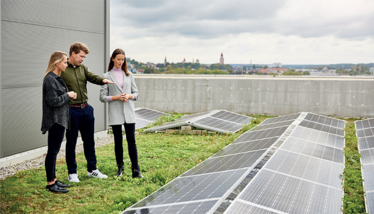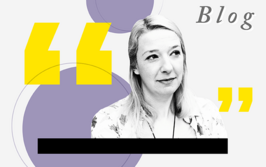Being Mindful of the World
From renewable energy to bicycle schemes and more; here are just a few examples of how a pharma business can be more sustainable
Stephanie Vine | | 10 min read

No matter how much we talk about our concerns for the environment or potential mitigating sustainability strategies, making real progress is challenging. But no one wants to be seen to be standing still – so, in recent years, numerous major international businesses have been called out for greenwashing (marketing sustainability as a major focus without taking any concrete action).
In the pharma industry, I’m pleased to say there are numerous examples of successful sustainability strategies. In 2022, a number of pharma CEOs (including AstraZeneca, Roche, GSK, Novo Nordisk, among others) announced joint action to help accelerate the move towards net zero health systems. Indeed, The Medicine Maker Company of the Year Awards 2023 saw GSK crowned by readers as one of the top companies for smart sustainability strategies.
But it’s not just big pharma that is investing in sustainability. In 2021, aseptic filling and packaging CDMO Vetter announced that all of its corporate sites were carbon-neutral. According to Vetter, “Sustainability today means keeping an eye on how our actions impact society, the economy, and ecology, and refers to the holistic responsibility that a company is prepared to assume in all spheres of life, as it stays mindful of the finite nature of resources.”
In 2022, the company won awards for climate engagement, sustainable impact, climate mobility, leadership, working conditions, and for improving bicycle and pedestrian traffic – among others. We spoke with Henryk Badack, Senior Vice President Technical Service and Internal Project Management at Vetter, to learn more about the company’s sustainability work.
When did Vetter decide to make sustainability a core part of its business strategy?
The topic of sustainability is not new to Vetter. I have been with Vetter for over 20 years and during this time the company has always had a long-term plan in sustainability. None of this has ever been about just obtaining a green label; it’s because a sustainable strategy is a good business strategy for both external and internal stakeholders.
From an external point of view, we – as a CDMO – are a very important part of the value stream and the supply chain of our customers. We are in the scope three calculation of our customers, which means that customers expect us to work on sustainability and reduce our carbon footprint. If we can reduce our carbon footprint, we also reduce the carbon footprint of our customers. Customers need their CDMO partners to be transparent. In addition, when comparing different service providers, customers will also strongly consider sustainability when deciding future business relationships.
From an internal perspective, our employees rely on us, and they want us to be prepared for the future because they want their jobs to be safe. They also want good working conditions. We are one of the biggest players in this region, so employees, their families, and communities rely on us. In addition, there are many local partners and suppliers who rely on us too. We’ve always believed in the three Ps: planet, people, and progress, and our sustainability strategy is rooted in our core philosophy to be a reliable and responsible company in this region – something that both our management and the family that owns Vetter are aligned on. Without their support and commitment, we wouldn’t be so successful.
In 2011, we adopted a truly holistic sustainability program. We also established a DIN ISO-certified environmental, occupational and safety management system, which we expanded in 2014 to cover the energy management system from the DIN ISO.
What other early actions did you take?
When I took over the department of environment, health, and safety at the company, I asked myself and the team what sustainability means holistically for us as a company – because I wanted to translate this message into easy and appropriate language for communication power. It wasn’t 100 percent clear to me where we stood. When you join any department, it’s a little like a navigation system in a car. First, you have to know your current position. Second, you have to know your destination. Third, you have to choose an efficient route. (Of course, when it comes to sustainability, no route is really bad because every bit of progress counts!)
We conducted an analysis to bring all our activities to the table to make them transparent and to understand our current position and progress. Over the years, we have invested in various infrastructure improvements and projects to reduce energy consumption, and have adopted energy efficient and environmentally friendly technologies. These actions were mainly focused on environmental aspects, but we felt it was important to develop a more holistic sustainability program with goals across the company.
Today, our sustainability program is based on four pillars. The first is the 17 sustainable development goals of the United Nations. These do not just cover environmental sustainability, but aspects such as no poverty, zero hunger, good health and wellbeing, quality education, gender equality, and so on. The second pillar is internal and external stakeholder dialogue, which includes our materiality metrics. The third is the DIN ISO 26000 guideline for social responsibility of organizations, and our fourth pillar is a collection of other guidelines, such as the EU’s Corporate Sustainability Reporting Directive and Taxonomy, code of conduct, and more.
What facts and figures can you share to highlight Vetter’s sustainability achievements?
I’m proud to say that we have generated many interesting figures! We have carried out more than 125 efficiency projects over the last decade. Since 2012, we have realized savings of more than 32 million kilowatt hours (equal to the consumption of 6,000 family homes per year) in electricity, natural gas, and biogas. We also began sourcing 100 percent renewable energy from hydropower starting in 2014. Since then, we have realized savings of more than 44,500 tonnes of carbon dioxide. We have invested approximately 9–10 million euros in special energy efficiency programs, and, since 2021, we have been carbon neutral at all sites. In 2022, we generated more than 7.3 million kilowatt hours of renewable energy with our own systems.
Some other important figures: our recycling rate is over 40 percent, which is very high for a pharmaceutical company, and we reduced our waste by 4.5 percent overall in 2022 – all despite growing the company. When I joined Vetter 20 years ago, we had around 1,400 employees, but today we have around 6,000 – and yet we are still able to reduce our waste and expand our sustainability efforts.
Our headquarters are based in a region with many villages, and we have calculated that our workforce commutes over 200,000 km every day to come to work, which is 5.5 circumnavigations of the Earth – daily! Therefore, over the years, we have developed comprehensive mobility concepts; for example, we have invested around 5 million euros to expand our mobility infrastructure at all sites, which includes bike rental stations on site and the implementation of charging stations for electric cars. We also encourage staff to use public transport for commuting by covering the cost of a public transport ticket. All this helps to reduce our carbon footprint.
Other facts to note include:
- implementing more mobile working options after COVID-19
- using locally sourced products in our canteens
- joining the United Nations Global Compact in 2022
- winning various awards for climate protection and the impact on employees
- achieving platinum status in the EcoVadis rating platform in 2023 (we achieved gold in 2022).
Though we can be proud of all these things, we must also recognize that we are not perfect. But we are very motivated, and I think we are on the right track.
How have customers reacted?
We find it very important to explain our sustainability programs to customers so that they can fully understand our impact on the environment and what we are doing to mitigate that impact. Our customers have also been impressed by our programs, and often use us as a role model for comparison with themselves or other suppliers. The topic of sustainability is now raised at almost every business review meeting or management meeting. Over the past 10 years, it has been incredible to see this topic receiving more focus. In some meetings with customers, sustainability is now at the very top of the agenda.
We cannot ignore that the pharma industry needs a lot of energy to produce its life saving products. For example, we have to run more than 20 cleanrooms in a 24/7 mode, and we need a high quality of resources, such as purified water and filtered air, to meet the high GMP requirements. Additionally, many filled products need to be refrigerated. We cannot avoid these needs; however, if we look at the entire value stream, there are opportunities in other areas for improvement – and that’s what our customers are looking for.
What advice do you have for companies that want to be more sustainable?
You need to find a balance that works for your company in the long term. You cannot invest in or run a company that is super profitable but not sustainable, but you also cannot invest in or run a company that is super sustainable but not profitable. It is unsustainable and bad social responsibility if you have to close a company and fire thousands of employees because you left profitability out of sight.
You should identify sustainability measures to understand the impact of your business on the environment and on society. Once you understand this, you can set goals for where you want to be. I would advise establishing a structure and governance, with named responsibilities. Create communication spaces where you can talk about your successes and challenges. And use networks to expand your reach. Look at what other companies are doing; exchange ideas, goals, and benchmarking data; and don’t forget to listen carefully to the ideas of your employees and what they are telling you about sustainability. It is important that you get all staff members engaged with your strategy – regardless of their level or role in the company.
How do you inspire your employees?
Our governance structure includes a sustainability team that meets on a weekly basis to discuss targets, challenges, new activities, and how we communicate those topics across the business. We have also established a sustainability circle with members from various departments; the goal is to bring people together every three months for cross-functional exchange of information, ideas, and challenges, and to discuss what we are hearing and seeing from customers.
We want to bring the issue of sustainability to everyone in the company. To inspire people, you have to talk to them. And that’s why a good culture of communication and exchange of information is important. We have created a sustainability report, which has had excellent feedback from staff members, customers, and suppliers. The 85-page report covers all our efforts and activities. Every time I read it, I am impressed by our achievements, and I am proud of the company and our teams.
To engage with our employees, we also created an information microsite that takes a deeper dive into sustainability as a whole. There, we explain, for example, the influence of the food industry on the individual carbon footprint and encourage our employees to be more mindful with the small changes they can make. We don’t just want employees to think about sustainability from a business perspective. All of us can play a role in making the world more sustainable, such as by thinking about what we consume and how much meat we eat, and so on.
If we are able to use the knowledge we have in our core team and circle, and combine it with the power of our supporters, management, the family owners, our employees, and their families, there are very few objectives we cannot achieve.

Making great scientific magazines isn’t just about delivering knowledge and high quality content; it’s also about packaging these in the right words to ensure that someone is truly inspired by a topic. My passion is ensuring that our authors’ expertise is presented as a seamless and enjoyable reading experience, whether in print, in digital or on social media. I’ve spent fourteen years writing and editing features for scientific and manufacturing publications, and in making this content engaging and accessible without sacrificing its scientific integrity. There is nothing better than a magazine with great content that feels great to read.


















